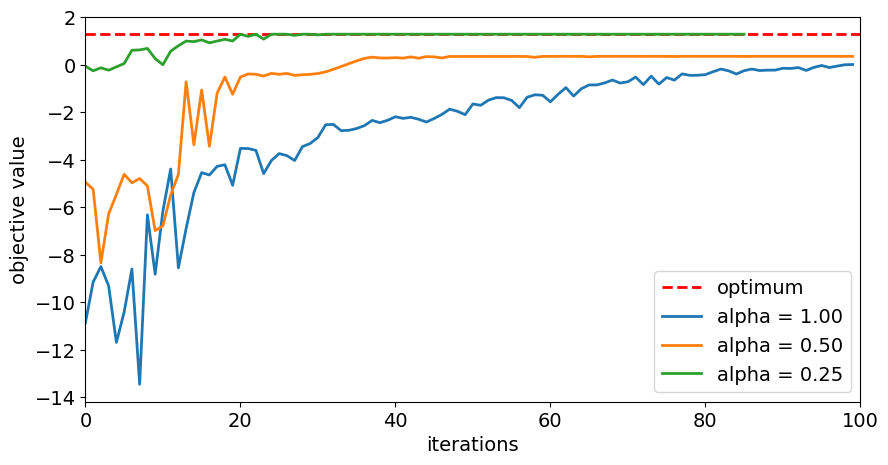নোট
এই পৃষ্ঠাটি docs/tutorials/08_cvar_optimization.ipynb থেকে বানানো হয়েছে।
CVaR দিয়ে পরিবর্তনশীল (ভ্যারিয়েশনাল) কোয়ান্টাম অপটিমাইজেশন উন্নতি করা#
ভূমিকা#
This notebook shows how to use the Conditional Value at Risk (CVaR) objective function introduced in [1] within the variational quantum optimization algorithms provided by Qiskit Algorithms. Particularly, it is shown how to setup the MinimumEigenOptimizer using SamplingVQE accordingly. For a given set of shots with corresponding objective values of the considered optimization problem, the CVaR with confidence level \(\alpha \in [0, 1]\)
is defined as the average of the \(\alpha\) best shots. Thus, \(\alpha = 1\) corresponds to the standard expected value, while \(\alpha=0\) corresponds to the minimum of the given shots, and \(\alpha \in (0, 1)\) is a tradeoff between focusing on better shots, but still applying some averaging to smoothen the optimization landscape.
তথ্যসূত্র#
[1] P. Barkoutsos et al., Improving Variational Quantum Optimization using CVaR, Quantum 4, 256 (2020).
[1]:
from qiskit.circuit.library import RealAmplitudes
from qiskit_algorithms.optimizers import COBYLA
from qiskit_algorithms import NumPyMinimumEigensolver, SamplingVQE
from qiskit_algorithms.utils import algorithm_globals
from qiskit.primitives import Sampler
from qiskit_optimization.converters import LinearEqualityToPenalty
from qiskit_optimization.algorithms import MinimumEigenOptimizer
from qiskit_optimization.translators import from_docplex_mp
import numpy as np
import matplotlib.pyplot as plt
from docplex.mp.model import Model
[2]:
algorithm_globals.random_seed = 123456
পোর্টফোলিও অপটিমাইজেশন#
[1] এ যেমন প্রবর্তিত হয়েছে আমরা তেমন নিম্নলিখিত একটি সমস্যা(প্রবলেম) দৃষ্টান্ত (ইনস্ট্যান্স) সংজ্ঞায়িত করছি পোর্টফোলিও অপটিমাইজেশনের জন্য।.
[3]:
# prepare problem instance
n = 6 # number of assets
q = 0.5 # risk factor
budget = n // 2 # budget
penalty = 2 * n # scaling of penalty term
[4]:
# instance from [1]
mu = np.array([0.7313, 0.9893, 0.2725, 0.8750, 0.7667, 0.3622])
sigma = np.array(
[
[0.7312, -0.6233, 0.4689, -0.5452, -0.0082, -0.3809],
[-0.6233, 2.4732, -0.7538, 2.4659, -0.0733, 0.8945],
[0.4689, -0.7538, 1.1543, -1.4095, 0.0007, -0.4301],
[-0.5452, 2.4659, -1.4095, 3.5067, 0.2012, 1.0922],
[-0.0082, -0.0733, 0.0007, 0.2012, 0.6231, 0.1509],
[-0.3809, 0.8945, -0.4301, 1.0922, 0.1509, 0.8992],
]
)
# or create random instance
# mu, sigma = portfolio.random_model(n, seed=123) # expected returns and covariance matrix
[5]:
# create docplex model
mdl = Model("portfolio_optimization")
x = mdl.binary_var_list(range(n), name="x")
objective = mdl.sum([mu[i] * x[i] for i in range(n)])
objective -= q * mdl.sum([sigma[i, j] * x[i] * x[j] for i in range(n) for j in range(n)])
mdl.maximize(objective)
mdl.add_constraint(mdl.sum(x[i] for i in range(n)) == budget)
# case to
qp = from_docplex_mp(mdl)
[6]:
# solve classically as reference
opt_result = MinimumEigenOptimizer(NumPyMinimumEigensolver()).solve(qp)
print(opt_result.prettyprint())
objective function value: 1.27835
variable values: x_0=1.0, x_1=1.0, x_2=0.0, x_3=0.0, x_4=1.0, x_5=0.0
status: SUCCESS
[7]:
# we convert the problem to an unconstrained problem for further analysis,
# otherwise this would not be necessary as the MinimumEigenSolver would do this
# translation automatically
linear2penalty = LinearEqualityToPenalty(penalty=penalty)
qp = linear2penalty.convert(qp)
_, offset = qp.to_ising()
Minimum Eigen Optimizer using SamplingVQE#
[8]:
# set classical optimizer
maxiter = 100
optimizer = COBYLA(maxiter=maxiter)
# set variational ansatz
ansatz = RealAmplitudes(n, reps=1)
m = ansatz.num_parameters
# set sampler
sampler = Sampler()
# run variational optimization for different values of alpha
alphas = [1.0, 0.50, 0.25] # confidence levels to be evaluated
[9]:
# dictionaries to store optimization progress and results
objectives = {alpha: [] for alpha in alphas} # set of tested objective functions w.r.t. alpha
results = {} # results of minimum eigensolver w.r.t alpha
# callback to store intermediate results
def callback(i, params, obj, stddev, alpha):
# we translate the objective from the internal Ising representation
# to the original optimization problem
objectives[alpha].append(np.real_if_close(-(obj + offset)))
# loop over all given alpha values
for alpha in alphas:
# initialize SamplingVQE using CVaR
vqe = SamplingVQE(
sampler=sampler,
ansatz=ansatz,
optimizer=optimizer,
aggregation=alpha,
callback=lambda i, params, obj, stddev: callback(i, params, obj, stddev, alpha),
)
# initialize optimization algorithm based on CVaR-SamplingVQE
opt_alg = MinimumEigenOptimizer(vqe)
# solve problem
results[alpha] = opt_alg.solve(qp)
# print results
print("alpha = {}:".format(alpha))
print(results[alpha].prettyprint())
print()
alpha = 1.0:
objective function value: 1.2783500000000174
variable values: x_0=1.0, x_1=1.0, x_2=0.0, x_3=0.0, x_4=1.0, x_5=0.0
status: SUCCESS
alpha = 0.5:
objective function value: 1.2783500000000174
variable values: x_0=1.0, x_1=1.0, x_2=0.0, x_3=0.0, x_4=1.0, x_5=0.0
status: SUCCESS
alpha = 0.25:
objective function value: 1.2783500000000174
variable values: x_0=1.0, x_1=1.0, x_2=0.0, x_3=0.0, x_4=1.0, x_5=0.0
status: SUCCESS
[10]:
# plot resulting history of objective values
plt.figure(figsize=(10, 5))
plt.plot([0, maxiter], [opt_result.fval, opt_result.fval], "r--", linewidth=2, label="optimum")
for alpha in alphas:
plt.plot(objectives[alpha], label="alpha = %.2f" % alpha, linewidth=2)
plt.legend(loc="lower right", fontsize=14)
plt.xlim(0, maxiter)
plt.xticks(fontsize=14)
plt.xlabel("iterations", fontsize=14)
plt.yticks(fontsize=14)
plt.ylabel("objective value", fontsize=14)
plt.show()

[11]:
# evaluate and sort all objective values
objective_values = np.zeros(2**n)
for i in range(2**n):
x_bin = ("{0:0%sb}" % n).format(i)
x = [0 if x_ == "0" else 1 for x_ in reversed(x_bin)]
objective_values[i] = qp.objective.evaluate(x)
ind = np.argsort(objective_values)
# evaluate final optimal probability for each alpha
for alpha in alphas:
probabilities = np.fromiter(
results[alpha].min_eigen_solver_result.eigenstate.binary_probabilities().values(),
dtype=float,
)
print("optimal probability (alpha = %.2f): %.4f" % (alpha, probabilities[ind][-1:]))
optimal probability (alpha = 1.00): 0.0000
optimal probability (alpha = 0.50): 0.0000
optimal probability (alpha = 0.25): 0.2895
[12]:
import qiskit.tools.jupyter
%qiskit_version_table
%qiskit_copyright
Version Information
| Qiskit Software | Version |
|---|---|
qiskit-terra | 0.25.0.dev0+1d844ec |
qiskit-aer | 0.12.0 |
qiskit-ibmq-provider | 0.20.2 |
qiskit-nature | 0.7.0 |
qiskit-optimization | 0.6.0 |
| System information | |
| Python version | 3.10.11 |
| Python compiler | Clang 14.0.0 (clang-1400.0.29.202) |
| Python build | main, Apr 7 2023 07:31:31 |
| OS | Darwin |
| CPUs | 4 |
| Memory (Gb) | 16.0 |
| Thu May 18 16:56:49 2023 JST | |
This code is a part of Qiskit
© Copyright IBM 2017, 2023.
This code is licensed under the Apache License, Version 2.0. You may
obtain a copy of this license in the LICENSE.txt file in the root directory
of this source tree or at http://www.apache.org/licenses/LICENSE-2.0.
Any modifications or derivative works of this code must retain this
copyright notice, and modified files need to carry a notice indicating
that they have been altered from the originals.
[ ]: